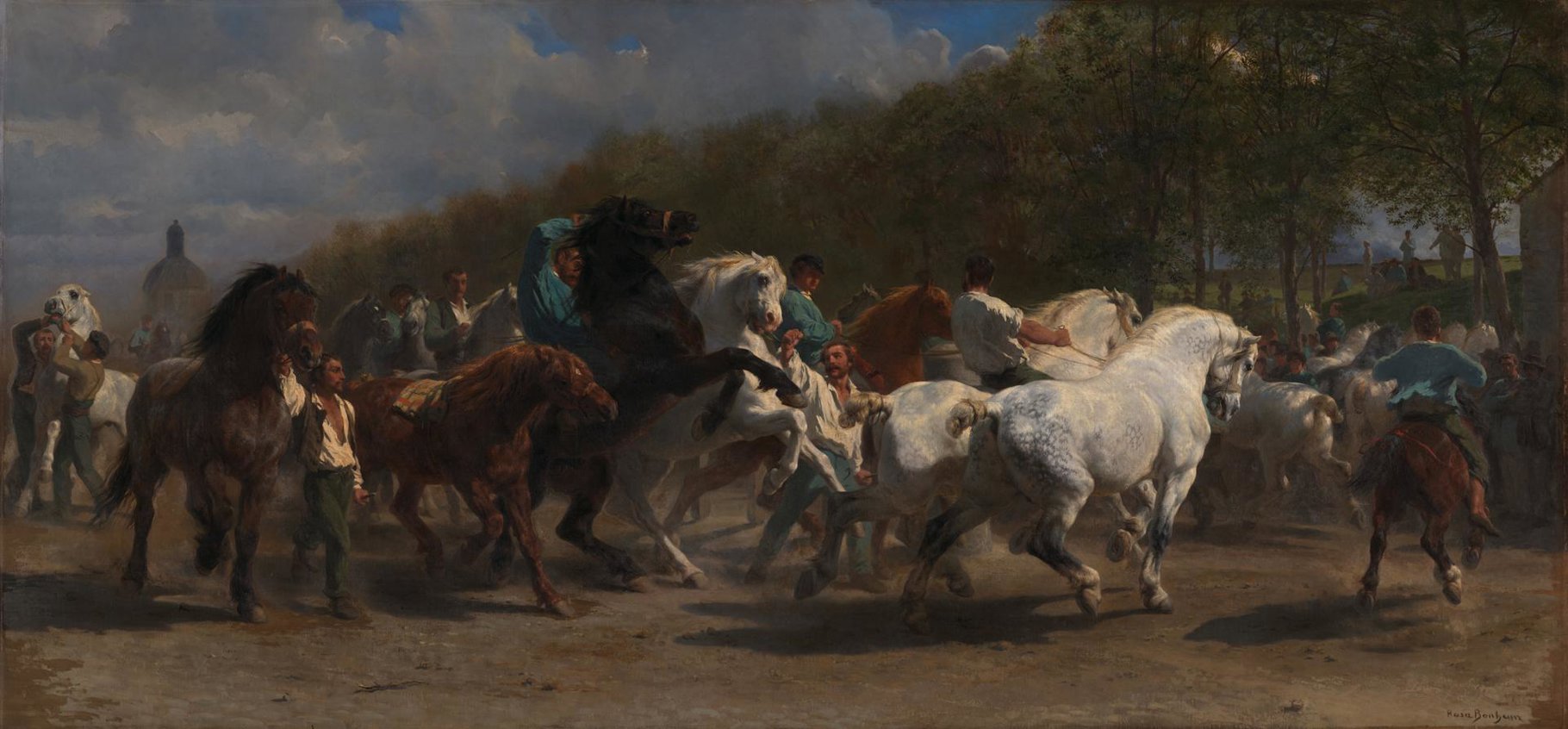Rosa Bonheur's 'The Horse Fair'
Audio description
This is a description of 'The Horse Fair' by Rosa Bonheur, painted in 1855. It is oil on canvas, 120 cm high and just over two and half metres wide, in landscape orientation. Around the painting is a wide gilded wooden frame, about a hands length in width, with thick relief entwined vines.
This is a noisy scene, full of excitement. Earthy tones dominate, with the feel of a crisp autumnal morning, as about 15 horses rear, gallop and plunge, moving left to right across the middle of the painting. They are brown, black and dappled white, their handlers, in blue or white shirts, riding them, or leading them on foot, sometimes struggling to control them.
The show is for us, as if we are the prospective buyers of these horses. The dappled white horses are Percherons, the strongest of them all. They have glossy sun-kissed coats, knotted tails, and muscular bodies. All the horses have been portrayed with fine brushwork, showing the details of their hair and muscle tone.
The top left corner of the painting is filled with a triangle of white fluffy clouded sky, dappled with sunlight and small patches of fresh bright blue, painted in bold vigorous strokes. This reaches 3 quarters along the top of the painting and about halfway down the left-hand side.
Behind the horses, in the mid-ground, is a bank of trees, dark green with tones of yellow and burnt umber, painted with a more stippled effect. On the far right, close examination reveals a grassy bank with people sitting and standing, watching from among the trees. On the left, in the far distance, is the dark grey domed roof and turret of a building, the Asylum of la Salpêtrière.
The foreground is painted in broad rough brushstrokes in browns and greys to convey the dry, dusty, earthen ground, with dark grey shadows from the horses.
In the centre of the painting one of the black horses rears up on its powerful hindquarters, the blue-shirted rider hanging on defiantly, one arm lifted to balance him. A white horse alongside, slightly behind, attempts the same, but because of the proximity is un-able to complete the move, resulting in a near collision. This is avoided by the moustachioed handler who is on foot, holding its bridle. Nearer to us, a smaller, riderless, chestnut brown horse, attempts to dash past the spectacle. Towards the left of the painting, a dark brown pony saunters along, led by its handler in dark brown trousers, and a white shirt undone to the navel, under an open
waistcoat. Behind them, two men struggle to control one of the white horses, both holding the bridle.
The spirit of the animal’s strength and presence, conveyed in this painting, engages us in the dangerous flurry. For over a year Bonheur attended the Horse fairs held in the Boulevard de l’Hôpital in Paris twice weekly, making sketches and absorbing the atmosphere. She applied for a ‘permission de travestissement’ from the local police so she could wear men’s clothes. This was a protective measure, avoiding unwanted male attention. She said, ‘they took me for a little lad.’
This painting is not the original, which is almost four times bigger and hangs in the Metropolitan Museum of Art, New York. The painting brought fame to the artist at a time when the work of women was largely disregarded. Due to its popularity, Bonheur was asked to paint this smaller version to facilitate the making of prints to sell.


